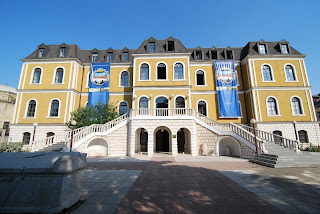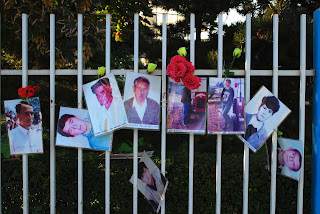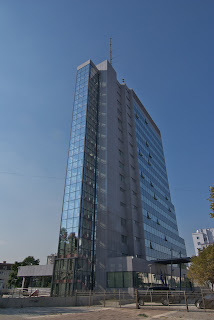Today's adventures centered around a visit to a landmark whose existence has weighed in the conscience of both Kosovars and Serbs for six centuries-- the Field of Blackbirds, Kosovo Polje, the site of the defeat of Balkan forces against Ottoman invaders in 1389.
On this field between 40,000 and 70,000 men perished in only 8 hours' time, and along with them the two Sovereigns who led them to battle - Tsar Lazar of Serbia and Sultan Murat I of the Ottoman Empire. When the dust settled the battle was effectively a draw, but the Balkan forces had been completely decimated. The demolished Ottoman army laying on the field represented only a fraction of Ottoman military might, and thus (what was at the time) Serbia fell to the Turk.
It seems that any chance of an objective account of the battle also perished on the field, for depending on who tells the story, the man who killed the Sultan (Milosh Obilich, Miloš Obilić) was either Serbian or Albanian. He may have stabbed the Sultan when he came to survey the casualties; alternately he may have asked for an audience with the Sultan and stabbed him when Murat offered his ring to be kissed. A third version has Obilic charging through a line of the Sultan's stunned bodyguards to stab him in the heart. No matter whose account attracts you, the result was the death of the only Sultan ever killed in battle.
The field itself offers few clues as to the horror that unfolded here. The land is almost conspicuously lacking in geographic features. It's as though the land is making penance for its historical notoriety by becoming geographically bland. The last of my photos here show Sultan Murat's tomb here-- although only his viscera were ever buried here (the rest of his body was buried in the Ottoman capital of the day, Bursa, and it remains there to this day). The 'tomb' itself is now maintained by the Turkish government, and has been well restored.
On a site nearer the actual battlefield stands a monument called the Gazimestan (Gazi- heroes, mesto- place = place of heroes) Monument, intended to memorialize the Serbian soldiers who fought and fell there. In more recent history, the monument served as the backdrop to one of Slobodan Milosevic's most infamous speeches, called the Gazimestan Speech, which is seen by many as one of the many warning signs leading up to the Yugoslav conflicts of the 1990s.
The monument is now guarded by about a dozen Kosovar police, who ask for passports before permitting entry to the facility. Once allowed inside, their interest in Andrew and I seems to have subsided entirely. We made our way up the stairs within the monument, lined with Serbian inscriptions of mysterious character and origin, to the observation deck atop the monument. From here we got a bird's eye view of the field itself (the otherwise nondescript photo of a plain). Additionally, it was easy to see the immense amount of noxious smoke pouring from the Kosovo A Power plant (the plant with 6 thin smoke stacks)-- notoriously the single largest point source of pollution in all of Europe, its effluence chokes Prishtina in the winter and blankets everything with a fine layer of dust that only the untreated exhaust of lignite coal can produce. From the monument it almost seems possible to taste the dust. Kosovo B stands to its right, a more modern looking plant, ostensibly somewhat less destructive. Our cab driver explained Kosovo A best when he described it as a "catastrophe." In a sense it seems to be a manmade disaster operating in slow motion.
The tomb of Murat (last half of the photos) and associated museum provided some interesting insights into a side of the story that has gained little sympathy with people in this region-- the Turkish perspective. The small tomb housing Murat's remains belie very little of his importance (he was only the third Ottoman Sultan-- grandson to Osman himself). We were greeted within the tomb by an elderly woman who spoke no English (and of whose native tongue we were equally ignorant). This barrier seemed to present no impediment to her, and she proceeded to explain a great deal to her effectively deaf guests. A few minutes into our guided tour, a younger man joined her, and began translating some of what she was telling us into English. Outside he pointed to a massive black mulberry tree, said to be over 400 years old, and rendered barren of fruit during the last two seasons due to the power plant's pollution. He also pointed to a small graveyard near the tomb, each marked with the surname Turbedar - tomb-keeper in Turkish. The woman who had been speaking with us was also a Turbedar, of the same family that had been maintaining this tomb for nearly six centuries.
Kosovo A doing what it does best (which I must say does not appear to be 'production of power')
The field of Kosovo, or field of blackbirds (who were said to have dealt with the bodies of the thousands of solider who fell here in their characteristic way)
Kosovo A visible again-- Kosovo B vaguely visible off to the right
Another of Kosovo A and part of the Field of Blackbirds from atop of the Gazimestan monument
Stairs inside Gazimestan Monument - they look sturdy enough. . .
Entrance to Gazimestan Monument - notice the striking broken sword motif!
Gazimestan from the bottom of the walkway leading upward. Strange tubular growths appear to be examples of the Socialist aesthetic.
"Whoever is a Serb and of Serb birth,
And of Serb blood and heritage,
And comes not to the Battle of Kosovo,
May he never have the progeny his heart desires,
Neither son nor daughter!
May nothing grow that his hand sows,
Neither dark wine nor white wheat!
And let him be cursed from all ages to all ages!"
And of Serb blood and heritage,
And comes not to the Battle of Kosovo,
May he never have the progeny his heart desires,
Neither son nor daughter!
May nothing grow that his hand sows,
Neither dark wine nor white wheat!
And let him be cursed from all ages to all ages!"
Inscription on Gazimestan Monument, Tzar Lazar
Signature of Turkish Prime Minister Recip Tayyip Erdogan in a visitors' book within the guest house/ museum.
Sultan Murat (center, with turban) and various 'historically enhanced' soldiers in uniform (Turkish soldiers did not dress this way for battle, our guide assured us- but these costumes made for a better museum display)
Monogram of Sultan Murat I (All Sultans had a special imperial seal/ monogram in highly stylized Arabic script. This one is one of my favorites for its simplicity.)
The black mulberry tree. Split down the middle, the Turkish government sent a tree specialist to attempt a repair. The results are admirable-- the concrete looking addition to the center of the trunk is actually a tar-sealed cloth painted to blend in with the tree, and the red concrete supports seem to be working to prevent any further collapse of the trunk. Interesting symbol-- a tree that rots and collapses from the inside out-- reminiscent of the Ottoman empire five centuries after Murat's death.
Tomb and casket of Murat (note the huge turban on the opposite end).
Explanation of funding and restoration of the monument.
Another of Murat's casket.
The outside of Murat's tomb









































